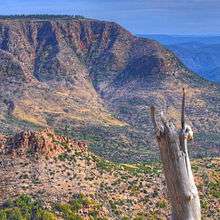Arizona transition zone

The Arizona transition zone is a diagonal northwest-by-southeast region across central Arizona. The region is a transition from the higher elevation Colorado Plateau to the northeast in Northeast Arizona and the Basin and Range region of southwest and south regions of lower elevation deserts.
Northwest Arizona transitions to the higher elevation Mojave Desert of southern California, Nevada and Utah, with an indicator species of Joshua trees and other species, and southwestwards regions of the Sonoran Desert, along the Lower Colorado River Valley; in Arizona's south, all of central and eastern desert Sonoran Desert regions merge southwards into Sonora Mexico. The transition zone includes the Mogollon Rim and the White Mountains and extends into western New Mexico.
In the Arizona ecoregion section, the Arizona transition zone is the major section of the EPA designated, Level III ecoregion, Arizona/New Mexico Mountains ecoregion. The other two outlier subregions to the transition zone in Arizona, are the Kaibab Plateau of the North Rim of the Grand Canyon, and associated ranges of the Chuska Mountains region of the northeast Arizona and northwest New Mexico.

Geography
The transition zone is dominated by the Mogollon Plateau at the southern edge of the Coconino Plateau of the Flagstaff region and the San Francisco volcanic field; the Mogollon Rim borders the plateau which extends from Oak Creek Canyon on the west, to the east at the highest elevations of Arizona in the central and western White Mountains.[1]
List of mountain ranges of the Arizona transition zone
The Arizona transition zone map is similar to the yellow transition region shown above.[2]
Central mountain ranges
|
|
Western region ranges
|
|
Eastern region ranges
|
|
See also
References
- ↑ Hendricks, J. D.; Plescia, J. B. (1991). "A Review of the Regional Geophysics of the Arizona Transition Zone". Journal of Geophysical Research. American Geophysical Union. 96 (B7): 12,351–12,373. doi:10.1029/90jb01781.
- ↑ Luchhitta, 2001. Hiking Arizona's Geology, Part 2, "Map Graphic": Arizona Transition Zone, p. 143-145. (and Hikes: 18-26, p. 145-182) ISBN 0-89886-730-4